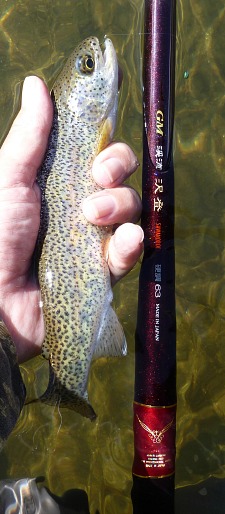Keiryu Techniques
for Tenkara Anglers
This is the talk I gave at the Appalachian Tenkara Jam in 2015.

Before I get started I’d like to thank Jason Sparks for hosting this event and thank all of you for coming to listen to me and the other presenters talk about fishing when you could be out there actually fishing. I hope that by the end of the weekend you feel like you’ve made the right choice.
I told Jason I’d speak about Keiryu Techniques for Tenkara Anglers
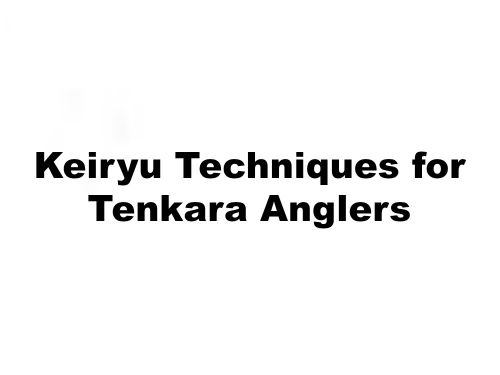
I know this is a tenkara event and I’m talking about keiryu, but I promise I’m not gonna try to lure you to the dark side. I just want to tell you about some aspects of keiryu fishing that I think could help you catch more fish.
I want to cover four main points:
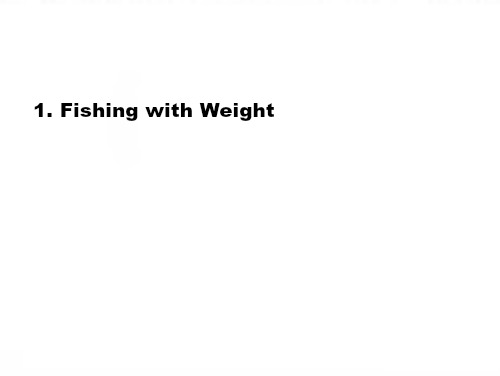
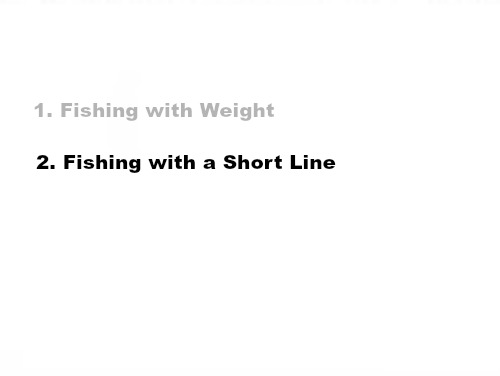
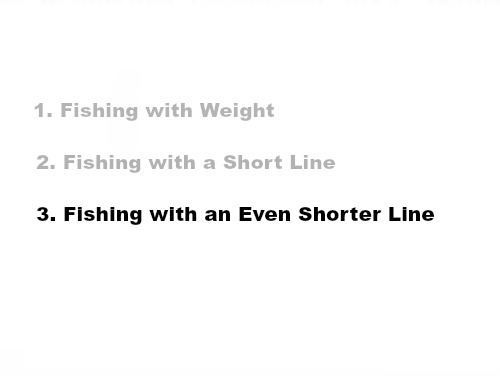
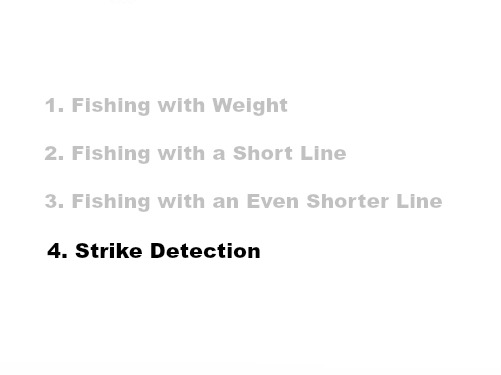
Along the way, I’ll talk a bit about rods and lines, which you won’t have to buy (although my booth is right over there).
Tenkara was developed in Japan as a method for fishing a single unweighted wet fly in the upper 6” of the water column, in relatively small, high-gradient mountain streams.
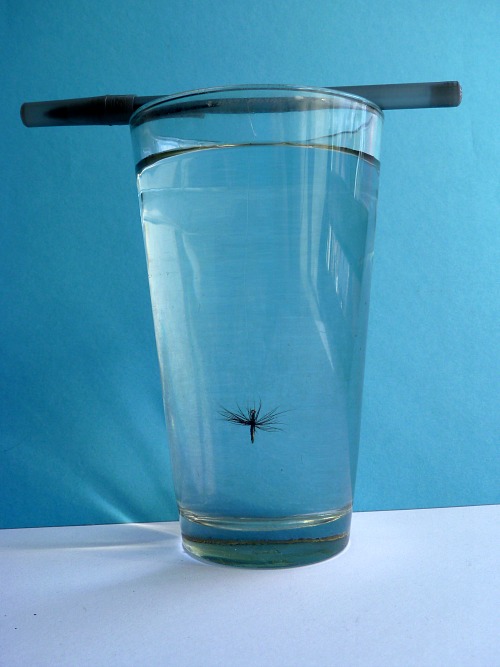
Now, you may laugh, but this slide was carefully chosen to illustrate three things:
Number 1- If you use your imagination, and if you have a very good imagination, it illustrates a fly in a mountain stream.
Number 2 – If you don’t have a mountain stream when you are putting together a slide presentation at the last minute, you have to improvise. But, but, carry that thought with you in all your fishing – improvise, think outside the box. PLAY!
And number 3 - And perhaps the most relevant for us here in Maryland: Tenkara fishers in Japan fish only in the mountain streams of Western Japan. Those crazy Americans will try tenkara anywhere. Doesn’t have to be mountains. Doesn’t have to be a stream.
And no, I didn’t catch anything.
Fishing unweighted wet flies in small, high gradient streams is what tenkara rods are designed to do and they are very, very good at it.
However, the further you get away from that narrowly defined method, the less good they are. And while they are very, very good at fishing in the top 6” of the water column, they’re not so hot at fishing in the bottom 6” of the water column.
The reason for that is the upper third to half of a tenkara rod is too soft. I used to say the tips were too soft but I have modified my views on that (and its recent enough that I haven’t gotten all the references on my website changed). It is soft to cast a light line – and in my view, the essence of tenkara is the light line, or rather the combination of the long rod and light line, which is what allows you to keep the line off the water’s surface. And that is absolutely critical for getting good drifts in a high gradient stream with lots of rocks and eddies and swirling currents.
In the steep, rugged mountains of Japan, any pool with deeper water is likely to be a plunge pool, where water doesn’t just flow in but drops in and plunges to the bottom.

It is said that if you want to get your fly deeper just cast into a plunge pool and let the flow take it down for you. If you are fishing a low gradient stream like a meadow stream, good luck finding a plunge pool. If you want to fish deep you will have to add weight. If you are fishing a river the Madison or Gallatin River in Montana,
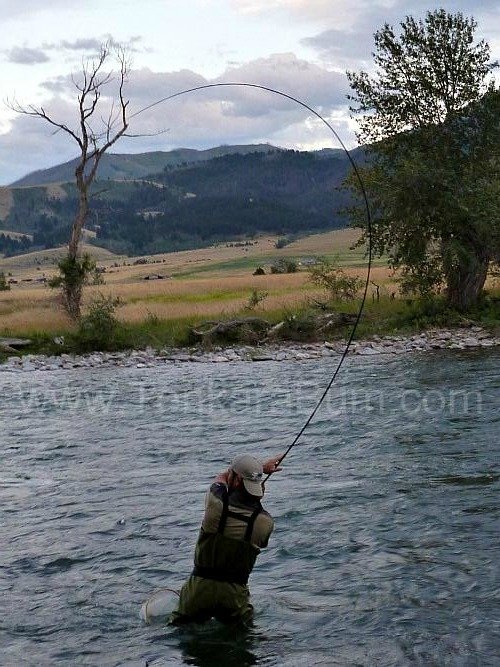
You’re not going to find any plunge pools. If you want to fish deep you will have to add weight. And on a river like the Gallatin, if there isn’t a hatch, you might have to get deep if you want to catch any fish.
Keiryu anglers cast the weight of the split shot. That way they can get their bait – and you can get your fly - to the bottom quickly even if there is no plunge pool. Why do you want to get to the bottom? That’s probably where the fish are.
Small mountain streams are generally pretty infertile. They don’t have prolific hatches of aquatic insects and much of a trout’s diet in those streams is going to be terrestrials. They’re always looking up.
In larger more fertile rivers, like the Madison, or the Arkansas, or the White or the Delaware, or in spring creeks, that isn’t always the case. If there isn’t a hatch, you might have to get down to where the fish are.
You basically have three choices, wire, like the underbody of a Killer Bug,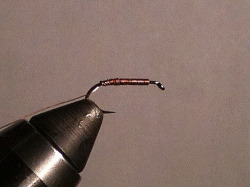
bead heads,
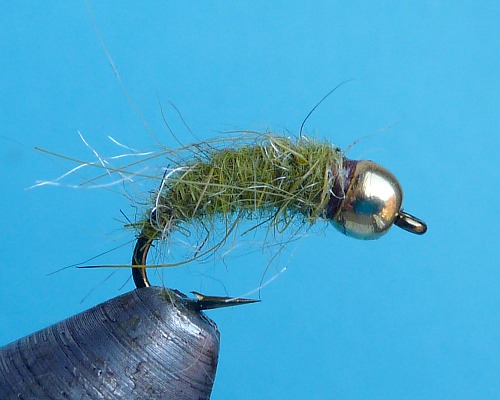
or split shot.
When I tried to find a good image of split shot on a line one image just stuck in my mind

Everybody awake now?
OK, I know this is a family event, and there could be minors present, but hey, that’s Hannah Montana, how bad could it be?
Like I was saying, split shot.
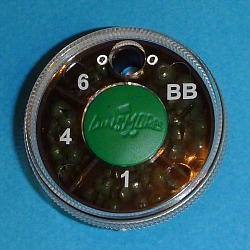
To be able to get good hook sets when fishing deep you have to pull line through water. That is not terribly difficult if there isn’t much line in the water and if it’s straight. Pulling line straight up is not difficult. If the line is not straight (and I’ll cover this more when we get to current differentials) there is a lot of resistance. Pulling line through the water sideways requires much more effort.
If you have to pull very much line through the water, fishing deep, you need a stiffer rod. If you have a softer rod, the rod is just going to bend and you need it to pull, not bend. Tenkara rods are not designed for that, keiryu rods are.
I started importing keiryu rods in early 2012. Just after the Daiwa Soyokaze,
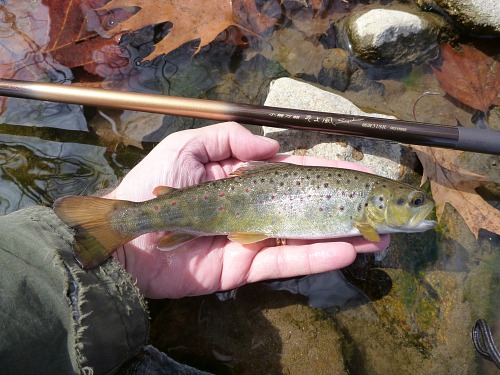
which I did not import for tenkara fishing but for micro fishing. It did not have a cork grip and it was not at least 11’ long (which was how tenkara rods were defined back then). However, the first time I had it out I was more than a little surprised that it could cast a tenkara line very well. I realized right then that a lot of the conventional wisdom of the time might have been conventional but it wasn’t wisdom.
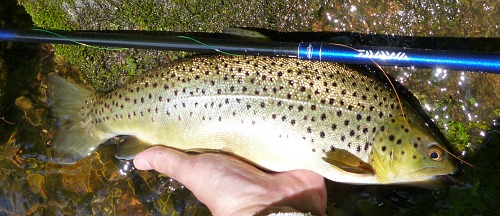
The Daiwa Kiyose 30SF, even more than the Soyokaze, was something different. Everyone who gets a tenkara rod tries Czech nymphing with it. It seems like a natural. It doesn’t work very well – the rods are too soft. The Daiwa Kiyose SF rods are not too soft.
Here’s a rod that did what people wanted a rod to do - fish heavy nymphs in deep water and fast current – and did it better than their tenkara rods. What’s more, it collapses to fit in a backpack and it’s light weight. It is actually a lot like the old Backpacking Light Hane, except it didn’t have a cork grip, and it collapsed to a shorter length and it weighed less, and oh, by the way, it’s also a lot less expensive.
The Daiwa Kiyose 30SF is a rod that broke barriers. It made people realize that perhaps what they wanted wasn’t a tenkara rod after all. What a rod is called is not important, what a rod does for you is. If you want to fish with weight - and that includes split shot, bead heads, cone heads, lead wire wraps, you want a rod that can handle it. You probably want a keiryu rod.
Let me digress a minute to define some terms.
Keiryu
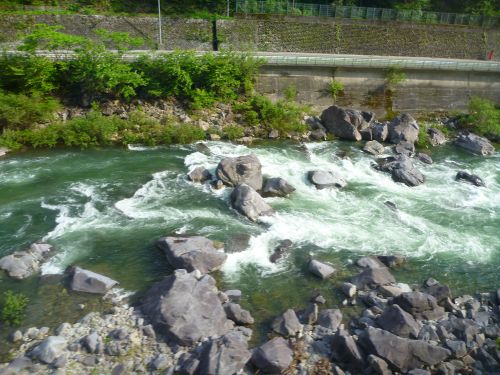
The word keiryu means mountain stream. In Japan the mountains are steep and rugged. The mountain streams are high gradient with lots of rocks and pocket water and plunge pools. Keiryu fishing is fishing in those mountain streams, and includes lure fishing, western fly fishing, tenkara and bait fishing.
If you look in any of the Japanese rod catalogs, you will see that lure fishing and western fly fishing are listed separately. If you pick up a keiryu fishing catalog, they won’t be in it. You’ll find pages and pages of bait fishing rods, followed by maybe one or two pages of tenkara rods. The tenkara rods are all labeled “tenkara” the others are just keiryu rods. And that’s why I call them keiryu rods. If Daiwa, Shimano, Gamakatsu, Nissin and Suntech list them as keiryu rods, why should I call them anything else?
And as for keiryu fishing, here in the US we already have widely accepted terms for spin fishing, for fly fishing and for tenkara. I suppose you could call what’s left mountain stream bait fishing for trout, but it is just a whole lot easier to just call it keiryu fishing, even if the term is not as all encompassing as it is in Japan.
Genryu
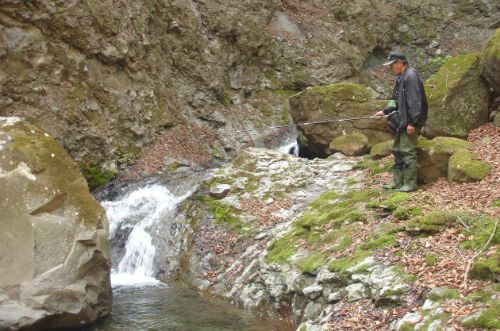
Genryu means headwaters, and it’s all hike in fishing. Picture a narrow canyon, no road, often little room to cast and frequent waterfalls. Now the waterfalls are not always high, but they’re almost always there. Fishing genryu streams pretty much means climbing up waterfalls, which in Japanese is called Sawanobori, which means shower climbing.
Genryu fishing could be the same lure, fly, tenkara or bait, but in practice is primarily bait fishing. With little casting room, the rods are not really designed for casting, so they don’t have to be soft and whippy. Fishermen essentially lower their bait (or fly) directly below the rod tip or make pendulum casts to get a bit more reach.
They use short lines – short enough that they have to collapse the rod to bring in the fish, which they often do with the fish up out of the water. You can’t do that very well with a soft rod. You may not want to fish that way, but it is effective and that’s why genryu rods tend to be stiff. They also collapse to very short lengths so they’ll easily fit in a backpack for the hike in and for climbing the waterfalls. Technically, the Daiwa Kiyose SF rods are Genryu rods, which are a subset of Keiryu rods and the catalogs all list them in with the keiryu rods.
Coming back to the US, shower climbing is not very popular at all, but Czech nymphing is. The stiffness that makes the rods appropriate for lifting a fish out of the water to bring it in also makes the rods extremely effective at keeping contact with heavy flies fished deep and for transmitting the feel of the take and for setting the hook.
OK, coming back to weight or split shot (no we’re not going back to that slide) you’ll have to stay awake without it. Tenkara fishing, like western fly fishing, casts the weight of the line, however light it is. The fly just gets towed behind the line. Keiryu fishing, though casts the weight of the split shot, so it doesn’t need to have a line heavy enough to cast.
The general weight of keiryu lines in Japan are probably equivalent to 6 or 7X tippet - almost never heavier than 5X and getting down to 9X or even thinner. So why does that matter. In a word, no two words, line sag. Line sag is death. This is what you don’t want:
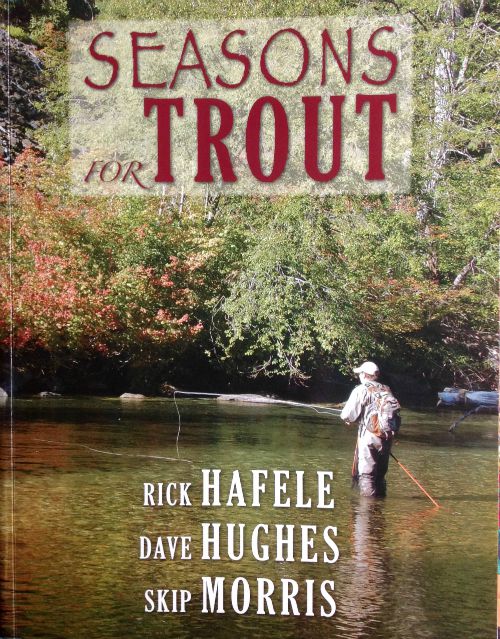
Well, Rick and Dave and Skip
might not be happy I said that, so let me do a little editing. This is what you don’t want:
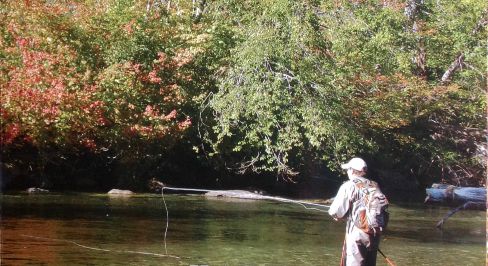
That ‘s regular floating fly line, doing what it does best, floating on the surface. That’s extreme line sag. Your line wants to fall straight down from the rod tip. But if your line’s straight down here and your fly’s way over there you get drag – lots of drag – unavoidable drag. The surface of the water in any stream is not one uniform current speed. There are micro current – or even huge current differentials from one foot to the next all the way across the surface. And if your line is snaking across the surface, pretty soon it will be like a snake. It won’t be straight. It will pull your fly. Matt Sment may give you the other side of the story for floating lines. And that illustrates just how far we’ve come in the last six years. Now people realize there IS another side of the story.
There are a couple ways to minimize line sag, but the simplest is to use a lighter line. So how light can you go? Well, what tippet can you get away with. 6X? Unless most of the fish you catch are in the upper teens, or larger, they’re not going to break 6X very often.
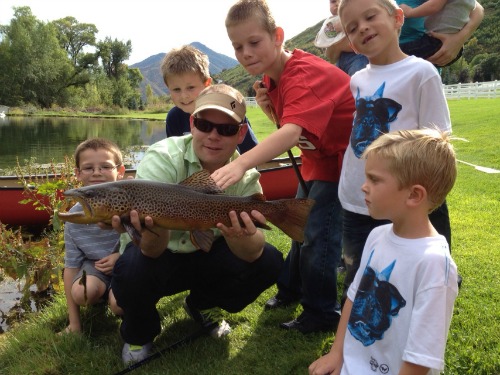
Here’s a 26” brown, caught on 6X tippet with a Daiwa Kiyose 33SF.
If you are casting the weight of the bead head, or the split shot, or for that matter, the weight of the copper wire and wet yarn on a Killer Bug, you can go 6X all the way to the rod tip. I wouldn’t recommend it, because you’ll probably find what I did, which is that when you break off a snag, your line is likely to break at the Lillian, not at the hook. Hook, line and sinker - gone. You’ll want a heavier line for part way, but 5X is heavier and you’re not going to get much line sag with 5X.
Of course, if you are fishing with 5X as your line, you won’t be able to see it. You have two choices. Some people – even with tenkara rods – use thingamabobbers as strike indicators. If you do you can see the thingamabobber – you don’t have to see the line. The second choice is to use keiryu markers,
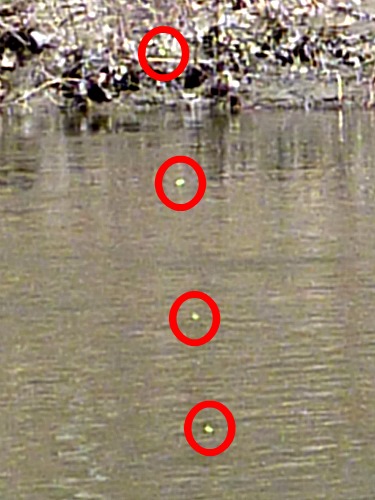
which are knots of thin fluorescent polypropylene yarn tied around the line. They are damn hard to photograph because an autofocus camera will always focus on the background but in practice they are very easy to see. If you tie them with longer tag ends, you can even see them in the late evening much easier than you can see the brightest Hi-Vis line. They don’t come with red circles, but you’ll find that you can see them much better in real life than on a slide.
I’ll come back to markers when we get to strike detection.
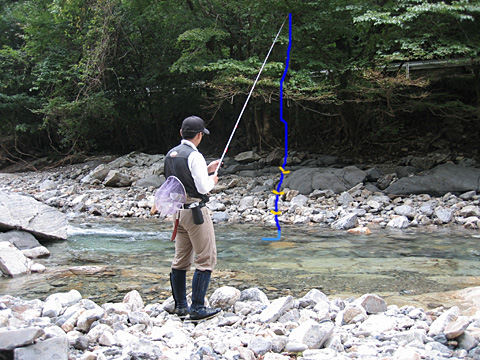
The problem with fishing with weight is that it will also want to hang straight down from the rod tip. There are advantages. You do get wonderful drag free drifts because your line is more nearly vertical so your fly (remember, you’re tenkara anglers so you’re not using those slimy, icky worms) is not subject to nearly as much current differential.
Also, since a vertical line from your fly to the surface is shorter than an angled line to the surface, it will be easier to pull the line through the water to get good hook sets. The big disadvantage is that if your line is hanging nearly vertically, you’re not fishing very far away.
I am convinced that is the primary reason why keiryu rods tend to be much longer than tenkara rods. The standard or average length for tenkara rods is probably 12’. For keiryu rods it’s 17 to 20’. You get unmatched drag free drifts, but you can still fish far enough away to not scare the fish.
So that’s fishing with weight. You can fish closer to the bottom which is where the fish will be if there isn’t a hatch. Since you’re casting the weight of the bead head or shot you can use a lighter line that has less line sag. If you leave the tag ends long on your markers you can see them long after you could no longer see tenkara line, so it’s great for fishing in the evening.
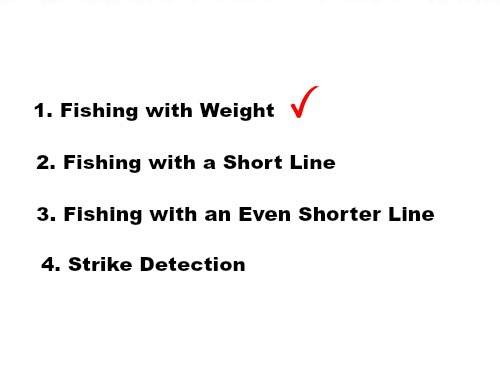
The length of the keiryu rods brings us to the second main point – using a short line. There are many different styles of tenkara. One of the styles that seems to get a lot of attention is long line tenkara.
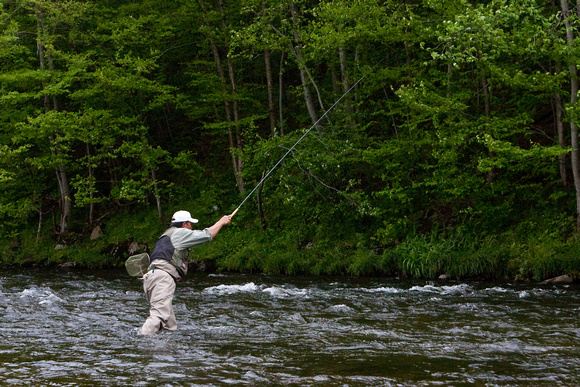
During Dr. Ishigaki’s tenkara demonstration in the Catskills in 2009 and California in 2010, he cast a 7 meter line with his 4.5m Shimano Perhaps the best example, though, is Masami Sakakibara, known as Tenkara no Oni, who is known for casting a line up to 10 meters long.
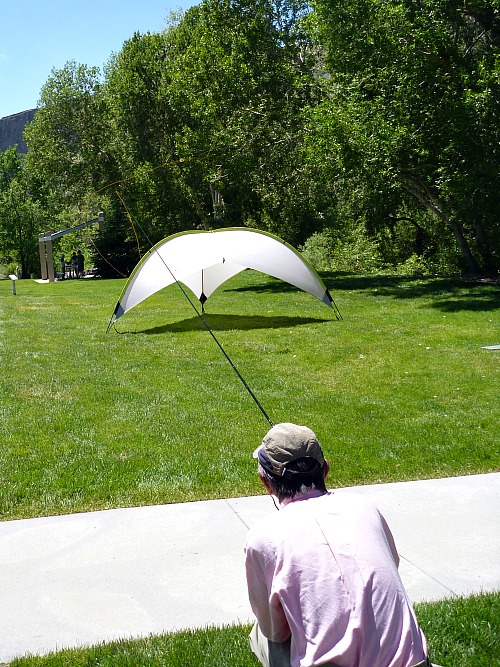
Here he is at the Oni School held a few weeks ago in Utah. He’s casting a 10 meter line with a 3.6 meter rod – and landing it under a sun tent. It was amazing to watch. Even more amazing, he had the students casting 10 meter lines, too.
Now, I don’t expect to ever fish with a 10 meter line, but it is an excellent tool for practicing your cast. With bad form you cannot cast a 10 meter nylon line. With good form you can, and that should make casting a 3 or 4 meter line second nature.
Long line tenkara is done on major rivers, the Honryu in Japan. It is also mostly done down and across targeting a bank eddy on the far side of the current. That is what Dr. Ishigaki is doing in this slide.

It sounds like you might want to do that, I mean the best place to fish is where no one else can. However, every silver lining has a cloud. You can pretty much only use it for a down and across presentation. If you are fishing upstream, or up and across, you will not be able to keep a long line off the water’s surface. You will get drag – maybe not instantaneously, but very, very soon.
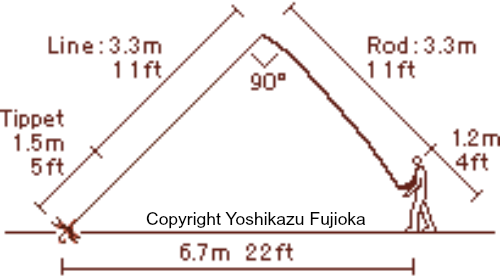
If you’ve been to Fujioka san’s great website for kebari patterns you’ve probably seen this image of casting distance. I didn’t include it for the distance calculation but to show what a perfect cast looks like – fly first, rod at 45 degrees – for a split second. Then it looks like this.
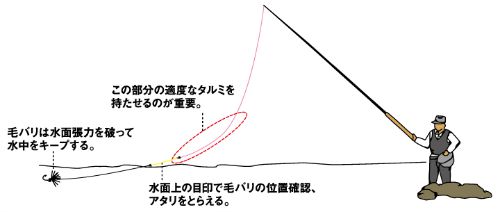
Back to that old nemesis line sag. But this time it’s different. This isn’t fly fishing line sag, this is tenkara line sag. This image is taken from the Daiwa website and Daiwa sells pink tenkara line. They also are now recommending using a contrasting hi-vis sighter, which I think I’ve only seen once before on a Japanese website. Maybe they read Teton Tenkara. Tom Davis is a big proponent of using a hi-vis sighter, and don’t think the Japanese rod and line companies don’t know what we are doing over here.
The line (and the sighter) is completely above the water’s surface, as it should be. However, look how much tippet is in the water. I can guarantee that there will be current differentials between here, where the tippet enters the water, and here, where the fly is. If you are fishing directly upstream that current differential will be minimized, but if you are fishing across, particularly in a rocky stream with lots of eddies and current seams, you can be sure that the water here and the water here are going to be flowing at different speeds.
The line will not be straight and it will be harder to get a hook set. The longer the line in relation to the rod, the more line is going to be in the water. Tenkara lines are made from a lot of different materials, but they’re not made from helium. They’ll sag.
There is another way to fish a bank eddy on the other side of current.
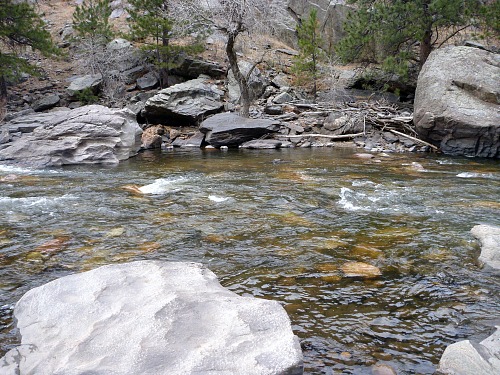
Here’s the setting – a big bank eddy on the far side. See that little rock in the eddy?
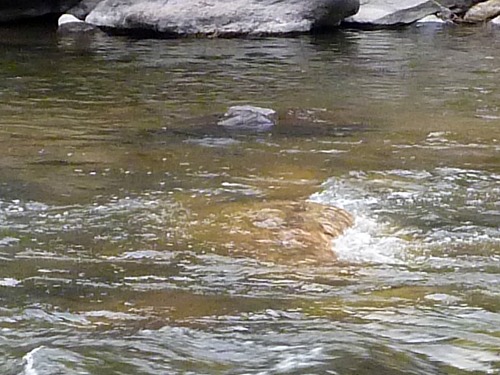
Now you can see it a little better. OK, I happened to see a fish rise in the center of the eddy, on the far side of that little rock.
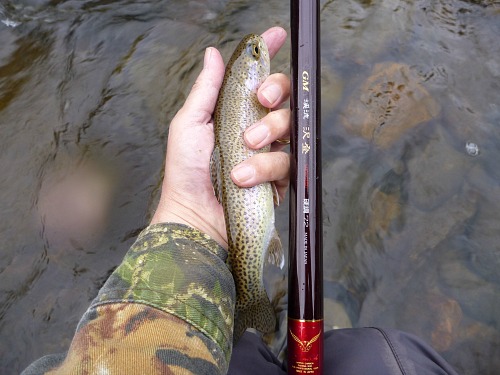
And here’s the fish that rose on the other side of that rock on the other side of the river. The rod was a Suntech Keiryu Sawanobori 72, a customer bought it and said take it out and see what it can do. I love customers like that.
The point is that you can use a 4.5 meter rod and 7 meter line but you can’t keep that much line off the water with that length of rod. I am sure you’ll have much more success with a 7 meter rod and a 4.5 meter line. You can keep all the line off the surface whether you are fishing upstream, downstream or across a raging current into a dead still bank eddy. Granted, there may not be many places in the Appalachians where you’ll want a 7 meter rod, but there aren’t that many places where you’d want a 7 meter line either.
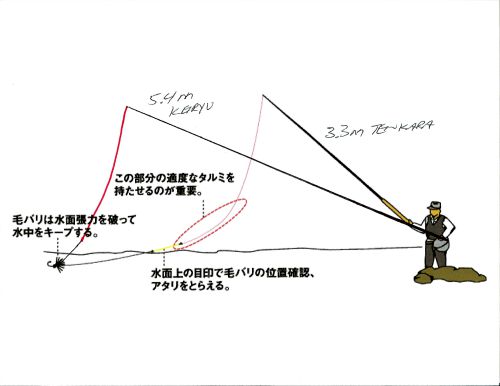
This slide shows the same Daiwa Pro angler and how he looks with a 3.3m tenkara rod and long line or with a 5.4m keiryu rod and a short line. The rods are drawn to scale.
Look at the difference in the amount of tippet that is in the water. I guarantee you, with the longer rod and shorter line you’ll have less drag. With less drag you’ll catch more fish. Keiryu anglers routinely use a line shorter than the rod.
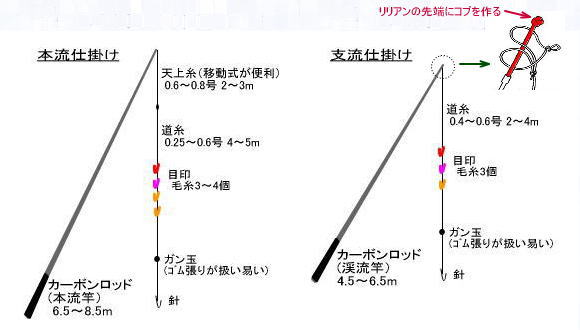
The rig on the left hand side is for the Honryu, the main rivers in Japan, where anglers frequently use 6.5 to 8.5 meter rods. Their lines are frequently 5 to seven meters long – about a meter and a half shorter than the rod. That squares with what I found even before I found this slide. My best ever day on a heavily fished stream not at all far from New York City was with a 6.3 meter rod and a line that was 4 feet shorter than the rod. I was fishing a Killer Bug and did much, much better than I had ever done on that stream.
Now I know most of you don’t have a 6 meter rod (yet) but I’ll bet a lot of you have an Ito. For a 4.5 meter rod, try a line plus tippet two or three feet shorter than the rod. You will be astounded at the quality of drifts you’ll get. If you fish dry flies, and who doesn’t, you can fish with only the fly and a few inches of tippet in the water. Perfect drifts. Absolutely perfect. OK, I’ve covered fishing with weight and fishing with short line.
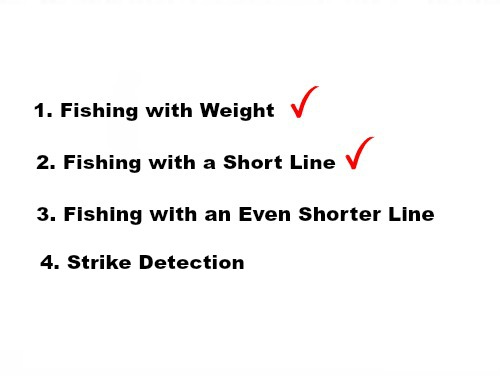
Now, for the third section we’re going to cycle back up to Genryu fishing, or rather a style of Genryu fishing called Lantern Fishing. It’s fishing with a long rod and a very short line, and it’s called lantern fishing because in the old days, people in Japan would carry lanterns tied to the end of a long bamboo pole with a very short cord. I suppose they could raise the lantern to see further, but in any event, that’s how it got its name.
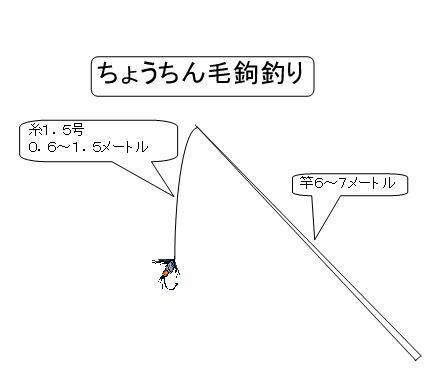
With a long rod and very short line, you can’t really cast. You can use a pendulum cast to get out past your rod tip, and you can flip the line to one side from your rod tip, but that’s about it. A lot of the time what they did is just lower their bait or fly directly into eddies or current seams or wherever they though a fish might be holding.
Oh my God, dropping a fly straight down from the rod tip sounds a lot like dapping.
Several years ago there was a movie called “Fight Club,” and the first rule of Fight Club was “you do not talk about Fight Club.” Well, the first rule of tenkara is you do not talk about dapping. Yeah, well, this is lantern fishing, not tenkara so it’s all good.
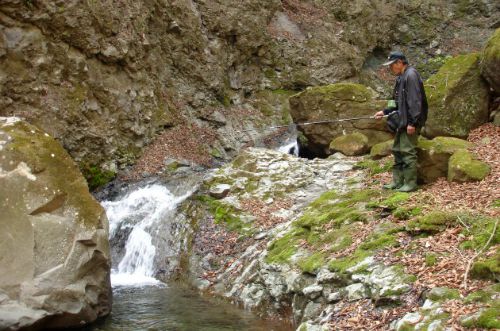
Actually, in the right situations it’s not just good, it’s very good. I’ll just give you two examples.
One was a small stream in the Catskills right along a road. There was a deep hole on the outside edge of a bend, right up against a vertical retaining wall for the road. The trees on the opposite shore had very low branches and there was slow water at the inside of the bend. Even if you could cast under the branches, your line would get caught in the slow water. No way to get a fly into that hole. The guy I was with, Ray Tucker, figured it out. He walked along the road, rod held out over the edge, heavy nymph bouncing along the bottom right through the hole and he watched the rod tip.
It looked kind of like this, but he was far enough back from the edge and the retaining wall was high enough that couldn’t even see the water. Of course, the fish couldn’t see him, either.
Bang. Fish on. I had to go down to net it for him ‘cause there was no way he could lift that fish. Then it was my turn, and sure enough it worked again.
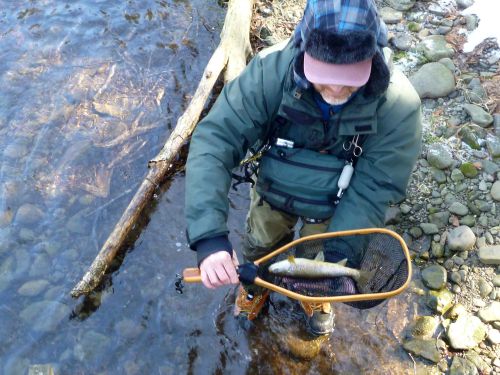
His fish was bigger, but he got there first.
Another time was actually pretty similar situation.
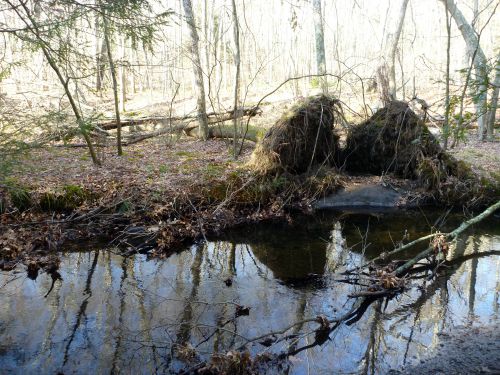
Fishing with a friend, we came across a deep hole on the outside edge of a bend, and no easy way to present a fly. I crossed the stream well below it, walked up to the bend then crawled up almost to the edge – far enough back that I couldn’t see the water and the fish couldn’t see me. I drifted a pink chenille worm through the hole, watching the rod tip. Bam! The rod tip dipped a foot.
Watching the rod tip also works for fishing on the other side of a big rock in the middle of the stream. With the rock in the way you can’t see your line but also, the fish can’t see you
This is also an option for fishing small tight overgrown streams. There is (or was) a Spanish style of fishing, whose name I have forgotten, that uses a 5m rod and about 2m line. They wade up small stream. No casting involved, just reach out and dap. Believe me, Daniel won’t care, this isn’t tenkara, it’s lantern fishing.
There’s another possibility for short line lantern style fishing that I think will prove to be extremely successful. You’ve all heard of high stick nymphing. How about low stick nymphing.
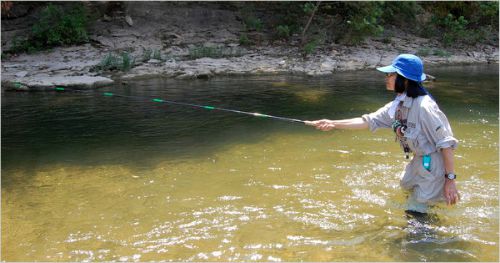
That’s Misako Ishimura, and if the name sounds familiar, it should. She coauthored the first book on tenkara written in English.
Her rod angle is so low, it looks as if she is Czech nymphing. Czech nymphing, or perhaps more accurately, Polish nymphing, initially was done with 9’ rods. Then 10’ rods. Now 11’ rods. How about a 14½ foot rod?
Earlier I mentioned casting into an eddy on the far bank with the Suntech Keiryu Sawanobori.
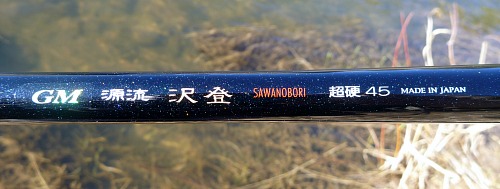
This is the Genryu Sawanobori. – It’s a headwaters rod. It’s light, it’s stiff, I think it has a lot of potential for being a dynamite Czech nymphing rod. That is a perfect application for a long rod, short line technique; a genryu technique. You will be very closely connected to your flies.
I’ve only gotten a chance to fish with the rod once, when I was out in Colorado for the Tenkara Winter Series. With the 14.5’ rod I used a 9’ line from rod tip to fly – 6’ of line and 3’ of tippet. Let me tell you, a 12” rainbow doing cartwheels at the end of a 9’ line is pretty exciting.
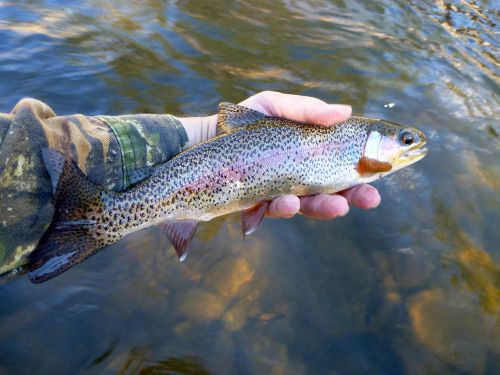
And that’s fishing with an even shorter line
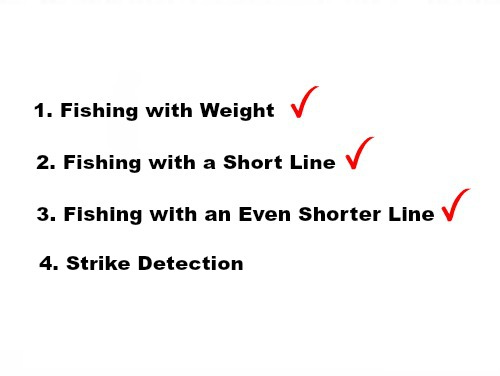
What you’ve heard so far is essentially the same talk I gave at the Midwest Tenkara Fest in Wisconsin in early May. The next section was not in that talk because I didn’t know it then. I learned it the day after the event.
You see there’s this miracle pool, the likes of which I will probably never experience again.
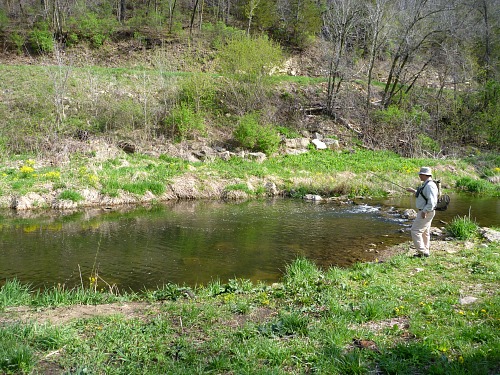
I call it that because five or six of us fished that one pool for several hours on Sunday evening after the event and the fish never stopped biting.
This is what the average fish looked like.
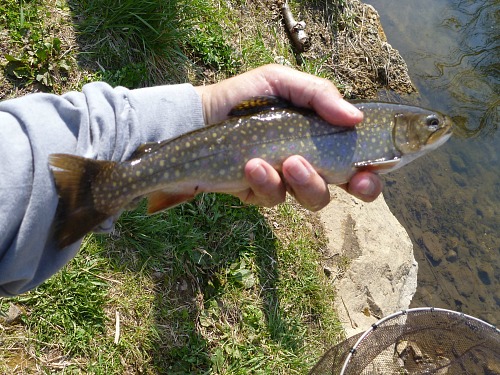
They were all wild brookies. The state does not stock brookies in that stream.
So there were five of six of us. Craig Thoreson and I were fishing 7 meter keiryu rods.
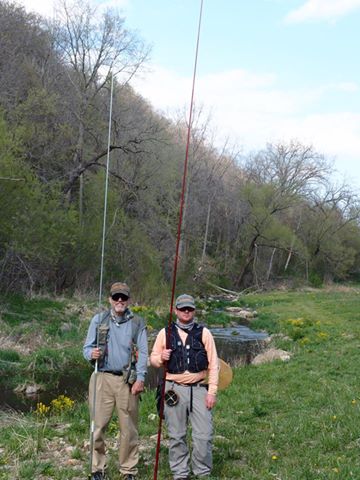
Now, with a 7 meter rod you have lots of reach, and if you don’t have overhead tree limbs, it’s all good.
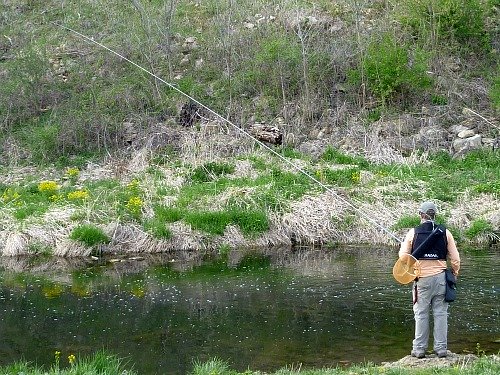
Craig and I were fishing salmon eggs and the other guys were fishing a number of different flies. Craig and I outfished the tenkara guys at least 5 to 1. I thought, and probably everyone there thought that was because we were fishing with bait rather than flies. Au contraire!
I went back on Monday evening, after everyone else had gone their separate ways. It was just as good – better because I didn’t have to share the pool. Literally, I caught a 10-12” brookie on every single cast.
The previous evening I had some trouble distinguishing when the line stopped from the shot or the egg hitting a rock from when the line stopped from a fish taking the bait. The first thing I did on Monday was adjust the marker so the shot and hook never hit the bottom. And they’re very easy to adjust – just move them to where you want them.
That did two things. 1). Anytime the line stopped, I knew it was a fish. That made strike detection much easier, and 2) a much greater percentage of the hits were signaled by the marker dipping rather than just stopping. The fish must have come up to take the egg and then gone back down. I was detecting strikes much faster than the previous evening.
There is a saying in nymph fishing that if you aren’t losing flies you aren’t fishing deep enough. The other side of that coin is that if your nymph is bouncing off rocks, you’re missing hits. I guarantee you some of those rocks were actually fish and you didn’t know it.
I was still catching a fish on every cast, and you know, after a while, even with 10-12” wild bookies, that gets a bit too easy. So, I started to experiment. How would it work with flies? I put on a Killer Bug tied with the Tupps yarn, which makes a very pink bug.
I stopped catching fish. I still saw some takes, but certainly not on every cast and I missed a lot of hits. I kept trying to react more quickly.
I should mention that I was using a very unconventional marker. In the previous slide I showed 4 markers on the line, and either three or four is standard, all of them with relatively short tag ends. Instead, I used just one marker, with very long tag ends.
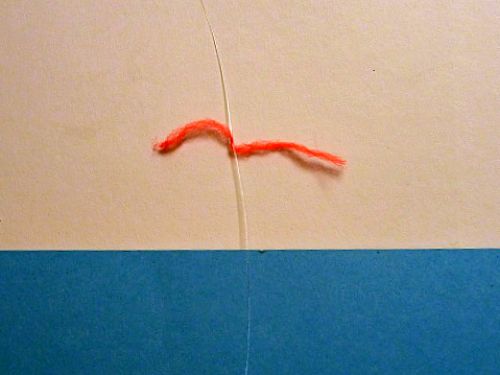
In addition to reacting more quickly, I began reacting to more and more subtle twitches in the marker. The long tag ends were a bit like butterfly wings. Very, very light with lots of air resistance. On the slightest tug down on the line the center of the marker dipped but the ends didn’t. It was easier to see the shape of the marker change than whether it actually dipped.
After reacting quicker and quicker, to more and more subtle twitches in the marker, I realized I was still getting a hit on every cast. Actually, with flies I got more hits, because if I wasn’t quick enough the fish spit it out and another hit it later in the drift. Like I said, I’ll never experience this again.
I also realized – mostly after the fact – that I could feel most of the hits as well as see them. I put that down to having an essentially straight, tight line from the rod tip to the fly.
And that, my fellow Jammers, reveals the real reason the tenkara anglers didn’t catch as many fish as Craig and I did the previous evening. It wasn’t because we were using bait. I got to the point where I was again catching a fish on every cast with Killer Bugs.
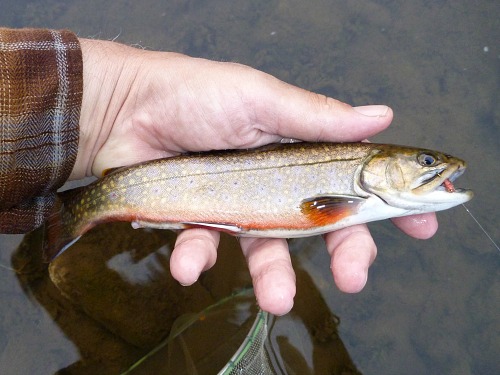
The reason the tenkara guys didn’t catch as many fish the night before was either that they didn’t get as good a drift because they had more line in the water or that they couldn’t detect a subtle strike because they had too much slack line. Probably both.
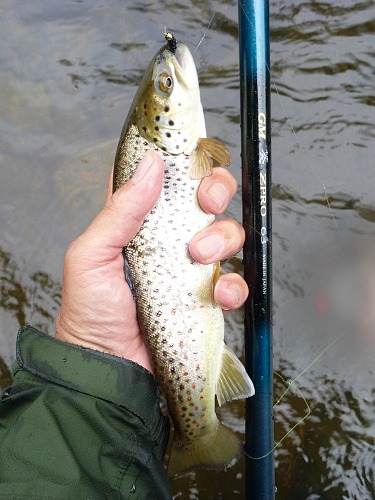
I got a chance to try the tight, nearly vertical line approach this past weekend - this time with a bead head black Killer Bugger and a new Suntech rod, the Blue ZPRO 63, which is rated for tippets as light as 10X all the way up to 6X, so it should be good for fish into the upper teens. Adjusting the marker so that it was a couple inches above the surface and the bead head was just above the rocks, it was just bang, bang, bang catching fish.
I’m just going to throw in one more technique, two handed casting.
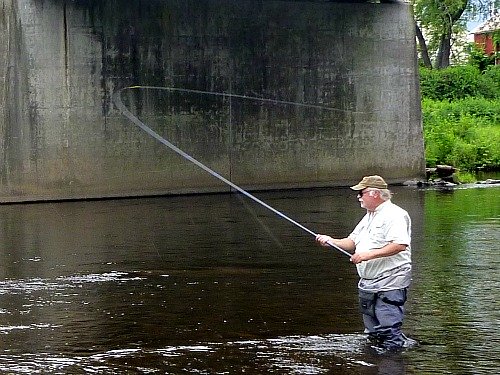
Once rods get longer than about 14’ most get a little tip heavy. They become too heavy or have too much inertia to cast one handed unless they’re light rods. Most of the 14 foot rods that all of you have are not light rods.
Also, if any of you have any wrist or elbow or shoulder problems, you know that casting can exacerbate the injury.
That’s Fred Krowchenko. He and his partners run Spey Casting Northeast. A couple summers ago I took some keiryu rods up for a class on two handed casting. He told me that many of their students take up two handed casting because of joint injuries. It really is much less stressful on all the joints. Your upper arm is essentially a fulcrum, and the lower arm only has to move a very short amount to move the rod tip enough to cast the line.
Plus, when you hold a fully extended rod with two hands, there isn’t nearly as much strain on your wrist. Give it a try some time.

If you only remember one thing from this talk, remember this slide. It illustrates the difference between a long line approach and a short line approach. With a longer rod and a shorter line, you’ll have less line in the water so you’ll get better drifts, and with better drifts you’ll get more strikes. Also, you’ll have less slack line so it will be easier to detect subtle strikes. Put the two together and I’m sure it will result in catching more fish.

So, those are some of the aspects of keiryu fishing that you can use in your tenkara fishing. I’m sure there are people who’d say none of that’s really tenkara. You know, the fish don’t care. I know some of you – probably most of you - already use weighted flies, so you’re part way there already.
But seriously, try the short line. You don’t have to buy a 5m or 6m rod to do it (although of course you could). Take your longest rod and use a line, rod tip to fly, no longer than the rod. For smaller streams use one shorter than the rod. You’ll get drifts like you’ve never gotten before.
You’ll be fishing closer to where you’re standing than you’re used to, so you’ll have to be stealthy. Stay low and move slow. I’d wear camo – hey, it can’t hurt.
I think you’ll be very surprised at the drifts you’ll get – and the fish you’ll get.
That’s my story and I’m sticking to it.

Does anyone have a question?
Update 8/18/15
After my presentation, I had a conversation with a customer who routinely catches larger fish than I do. I don't know if the difference is where he fishes or how he fishes, but suffice it to say he catches much larger fish than I do. He told me then, and again recently in an email exchange, that if he doesn't have his rod tip high when he hooks a large fish, the fish will immediately pull the bend out of the rod, pull the rod tip down and break the tippet.
I think you can keep your rod tip high enough if the line plus tippet is equal to the rod length but if it is substantially shorter than that you can't. The closest I've come to that experience was fishing with a 14.5 foot rod and a 9 foot line, including tippet. I had a hard time keeping a bend in the rod with a 12" trout on the line. Had it been a 22" trout I wouldn't have been able to.
The rod could have handled a fish of that size, but I would have had to have a line long enough to keep the rod tip up when the fish made its first run.
Lantern fishing in Japan does use a very short line, but they don't catch 22" fish. If you do - or if you want to - you won't need a long line, but you will need a line long enough to keep a bend in the rod.
At the Jam, Rob Worthing of the Tenkara Guides gave an excellent presentation on catching big fish. Rob is also a customer, and also catches much larger fish than I do, but he is not the one who told me that a short line approach wouldn't work.
TenkaraBum Home > Keiryu Techniques for Tenkara Anglers
“The bitterness of poor quality remains long after the sweetness of low price is forgotten” - Benjamin Franklin
"Be sure in casting, that your fly fall first into the water, for if the line fall first, it scares or frightens the fish..." -
Col. Robert Venables 1662
As age slows my pace, I will become more like the heron.
Warning:
The hooks are sharp.
The coffee's hot.
The fish are slippery when wet.
Beware of the Dogma
What's in stock?
Suntech Tenkarakyo 40F Tenkara Rods
Suntech Kurenai II AR39F
Seiryu Rods
Coming Soon
Latest Pages
|
Most keiryu anglers use a line/rig the same length as the rod or 1-2 ft shorter. It is all about the tight line and drift control just like tenkara.
You drift your bait just as you would a kebari. Same fishing tactics are used. Accurate bait cast is essential. This is not a huck it anywhere in the water and wait. It is very active fishing just like tenkara. I have found that keiryu fishing is equally as challenging as tenkara. I have personally been using keiryu methods in the big rivers. I know that keiryu anglers in Japan fish small mountain streams but I prefer tenkara for that. John V, Utah |
If you enjoy spin fishing or baitcasting please visit my sister site Finesse-Fishing.com.



